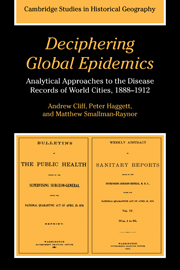 Deciphering Global Epidemics
Deciphering Global Epidemics Book contents
- Frontmatter
- Contents
- List of plates
- List of figures
- List of tables
- Foreword
- Preface
- 1 Prologue: epidemics past
- 2 The nature of the evidence
- 3 The global sample: an overall picture
- 4 Epidemic trends: a global synthesis
- 5 Comparing world regions
- 6 The individual city record
- 7 Epidemics: looking forwards
- Appendices
- A Primary data sources
- B International epidemiological sources
- C National epidemiological sources
- D International and national epidemiological agencies
- Chapter notes
- References
- Index
- Cambridge Studies in Historical Geography
C - National epidemiological sources
Published online by Cambridge University Press: 06 July 2010
- Frontmatter
- Contents
- List of plates
- List of figures
- List of tables
- Foreword
- Preface
- 1 Prologue: epidemics past
- 2 The nature of the evidence
- 3 The global sample: an overall picture
- 4 Epidemic trends: a global synthesis
- 5 Comparing world regions
- 6 The individual city record
- 7 Epidemics: looking forwards
- Appendices
- A Primary data sources
- B International epidemiological sources
- C National epidemiological sources
- D International and national epidemiological agencies
- Chapter notes
- References
- Index
- Cambridge Studies in Historical Geography
Summary
The following alphabetical list details the major epidemiological sources for the countries of the world in which our 100 cities are located (see tables 3.3 and 3.4). Within each country, the material is arranged under three headings: (a) sources of morbidity data, (b) sources of mortality data, and (c) sources of population data. Information is listed under the current (1995) names and jurisdictions of the respective countries. Where necessary, these are cross-referenced with the 1888–1912 names and jurisdictions indicated in tables 3.3 and 3.4.
The countries listed fall in one of six World Health Organization regions, viz. (a) European Region, (b) Eastern Mediterranean Region, (c) South East Asian Region, (d) Western Pacific Region, (e) African Region, and (f) American Region. Readers should refer to the WHO Regional Offices or to the national epidemiological agencies whose addresses are given in appendix D for recent changes.
AUSTRALIA. Commonwealth of Australia. WHO Western Pacific Region (WPR). Area: 2,974,581 miles. Population: 18.3 million (1995). European colonisation from late eighteenth century with the six colonies federated into the Commonwealth of Australia from 1901. (a) Sources of morbidity data: Reported cases of notifiable infectious diseases are regularly reported in: Notification Diseases Report (weekly); Communicable Diseases Intelligence (fortnightly). Annual information on the incidence and immunisation coverage of eight vaccine-preventable diseases (diphtheria, measles, pertussis, poliomyelitis, tetanus, neonatal tetanus, tuberculosis, and yellow fever) from 1974 is given in the Information System Summary Volume, WHO Western Pacific Region (WHO, Expanded Programme on Immunization (EPI), Geneva, annual), (b) Sources of mortality data: Standardised mortality tables giving 178 causes of death for males and females are given for Australia by quinquennial periods for the period 1906 to 1975 in International Mortality Statistics (Alderson, 1981, tabs. 1–178, pp. 113–477).
- Type
- Chapter
- Information
- Deciphering Global EpidemicsAnalytical Approaches to the Disease Records of World Cities, 1888–1912, pp. 396 - 417Publisher: Cambridge University PressPrint publication year: 1998


